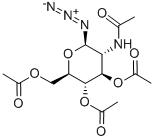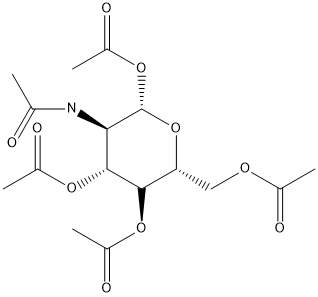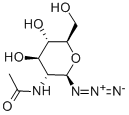2-Acetamido-3,4,6-tri-<i>O</i>-acetyl-2-deoxy-β-<small>D</small>-glucopyranosyl Azide , >98.0%(HPLC) , 6205-69-2
Synonym(s):
2-Acetamido-3,4,6-tri-O-acetyl-2-deoxy-β-D -glucopyranosyl azide
CAS NO.:6205-69-2
Empirical Formula: C14H20N4O8
Molecular Weight: 372.33
MDL number: MFCD00216968
EINECS: 612-938-3
| Pack Size | Price | Stock | Quantity |
| 200MG | RMB159.20 | In Stock |
|
| 250mg | RMB239.20 | In Stock |
|
| 1G | RMB529.60 | In Stock |
|
| 5G | RMB2160.00 | In Stock |
|
| others | Enquire |
PRODUCT Properties
| Melting point: | 128-130°C |
| Boiling point: | 501.81°C (rough estimate) |
| Density | 1.2964 (rough estimate) |
| refractive index | 1.6200 (estimate) |
| storage temp. | Freezer |
| solubility | Chloroform, Dichloromethane, Ethyl Acetate |
| form | Solid |
| color | White |
| optical activity | [α]/D -45.5±2.5°, c = 1 in chloroform |
| CAS DataBase Reference | 6205-69-2(CAS DataBase Reference) |
Description and Uses
β-D-Glucopyranosyl azide, 2-(acetylamino)-2-deoxy-, 3,4,6-triacetate is commonly used in organic synthesis, particularly for the preparation of glycosyl azides, which are versatile intermediates in the synthesis of glycoconjugates. In carbohydrate chemistry, it can be employed for modifying and functionalizing carbohydrates, including the introduction of azide groups. These azide-modified carbohydrates can participate in click chemistry reactions, enabling the development of bioconjugates and glycoarrays. In drug discovery, this compound aids in the design and synthesis of carbohydrate-based therapeutics, such as glycosidase inhibitors or glycoconjugate vaccines, by modifying carbohydrate structures. For biochemical research, this compound is valuable in studying carbohydrate-protein interactions, glycan biosynthesis, and glycoprotein engineering. It allows for the modification and labeling of carbohydrates for subsequent biological assays and analyses. Finally, as an azide derivative, it finds application in click chemistry reactions, specifically the azide-alkyne cycloaddition reaction (commonly known as the "click reaction"). This reaction enables efficient and selective labeling, bioconjugation, and cross-linking in various biological and materials science applications.
Safety
| WGK Germany | 3 |
| HS Code | 29329990 |





